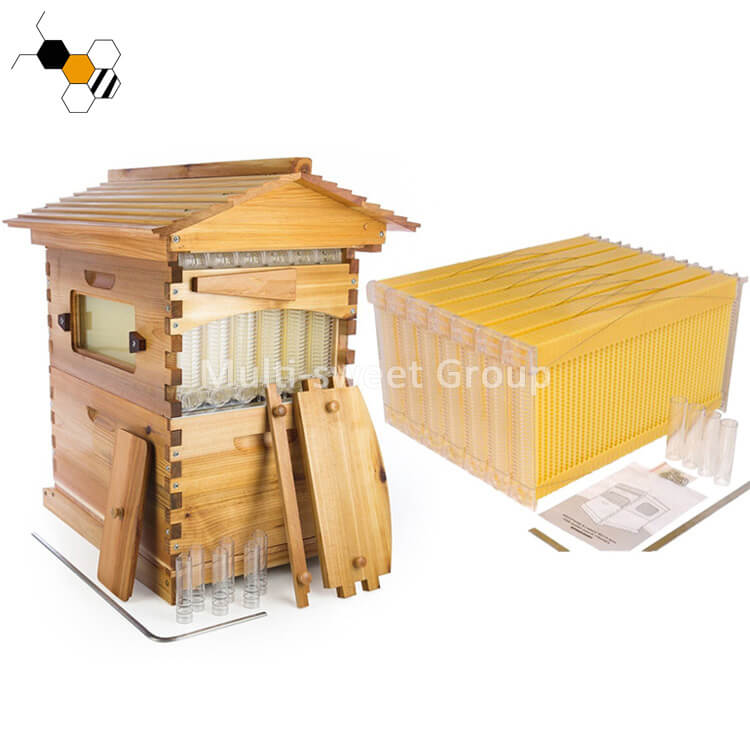How Do You Harvest Flow Hive?
How to harvest flow hive? How do you know when a autoflow hive is ready to harvest? And how much can l harvest from the flowing hive? This article will tell you all about that.

How do you harvest flow hive?
Harvesting honey using flow hives are a bit different than traditional Langstrosh hives honey harvesting, as it involves releasing the honey from the frames directly into a container without removing the frames from the beehive. Here are the general steps for harvesting honey using a flow hive:
1. Check that the honey frames are at least 80% capped with honey, meaning that the bees have sealed the cells with wax. This ensures that the honey is mature and ready for harvesting.
2. Prepare your harvesting equipment, which may include a container to collect the honey, a bee brush, and protective bee suits such as bee gloves and a bee veil.
3. Remove the caps on the honeycomb cells using a flow hive tool or another uncapping tool. This will allow the honey to flow freely out of the combs.
4. Turn the flow hive key to open the honeycomb channels and release the honey. This will take a few minutes, depending on how much honey is in the frames. You can watch the honey flow into your collection container.
5. Once the honey has stopped flowing, close the honeycomb channels and remove the collection container.
6. Put the honeycomb caps back on the frames and return the frames to the beehive.
7. Clean your harvesting equipment and store it for future use.
Keep in mind that proper timing and technique are important to ensure a successful honey harvest and minimize disruption to the hive. Consult with us, Multi Sweet Group, a professional Apiculture manufacturer for your flow hive.
How do you know when a flow hive is ready to harvest?
Knowing when a flow hive is ready to harvest honey is an important part of beekeeping. Here are some factors to consider when determining if your flow hive is ready to harvest:
1. Honeycomb cells should be at least 80% capped with wax. This indicates that the honey inside has ripened and is ready for harvesting.
2. Observe the bee’s forager behavior. When nectar flow is strong, foragers are less likely to be present in the hive, indicating that they are out collecting resources. This is a good sign that the honey flow is strong and that your hive may be ready for harvesting.
3. Use your beekeeping experience to determine the best time for harvesting. Depending on your local climate and resources, the timing for harvesting honey may vary seasonally. Experienced beekeepers can often use their intuition and assessment of the flow conditions to make a good decision.
4. Consider using a refractometer to measure the moisture content of the honey. Honey with a moisture content below 20% is ready for harvesting.

How much can you harvest from the flow hive?
The amount of honey you can harvest from a flow hive varies depending on several factors, such as the size of the hive, the strength of the hive colony, the time of year, and the local availability of nectar and pollen. Beekeepers can generally expect to harvest between 10 to 100 pounds of honey per flow hive per season, although some beekeepers have reported harvesting up to 120 pounds.
It’s important to note that honey production is never guaranteed, and factors such as weather patterns, environment, and colony health can all impact honey production. Additionally, harvesting too much honey can be harmful to the bees, and it’s important to leave enough for the bees to feed on during the winter months.
If you are using a flowing hive, it’s a good idea to monitor honey production throughout the year and harvest only when the hive has enough surplus honey to support both the bees and allow for honey harvesting without harming the colony.

It’s important to check your autoflow hive regularly for signs of honey readiness and flow conditions, to ensure that you don’t harvest too early or too late, which could have negative effects on your hive and honey production. Leave a message or click on the contact us button to consult us for specific guidance on using a flow hive for honey harvesting For Free now!


